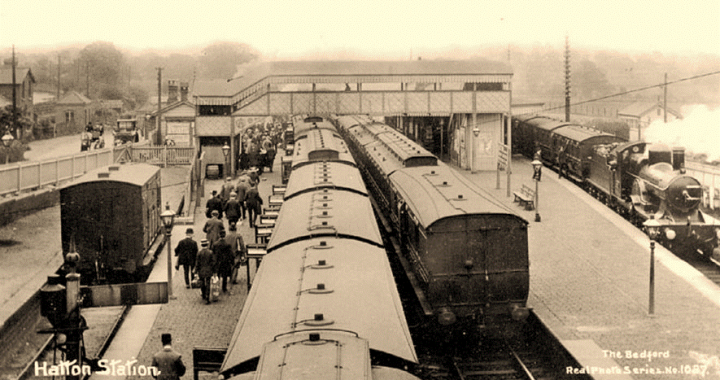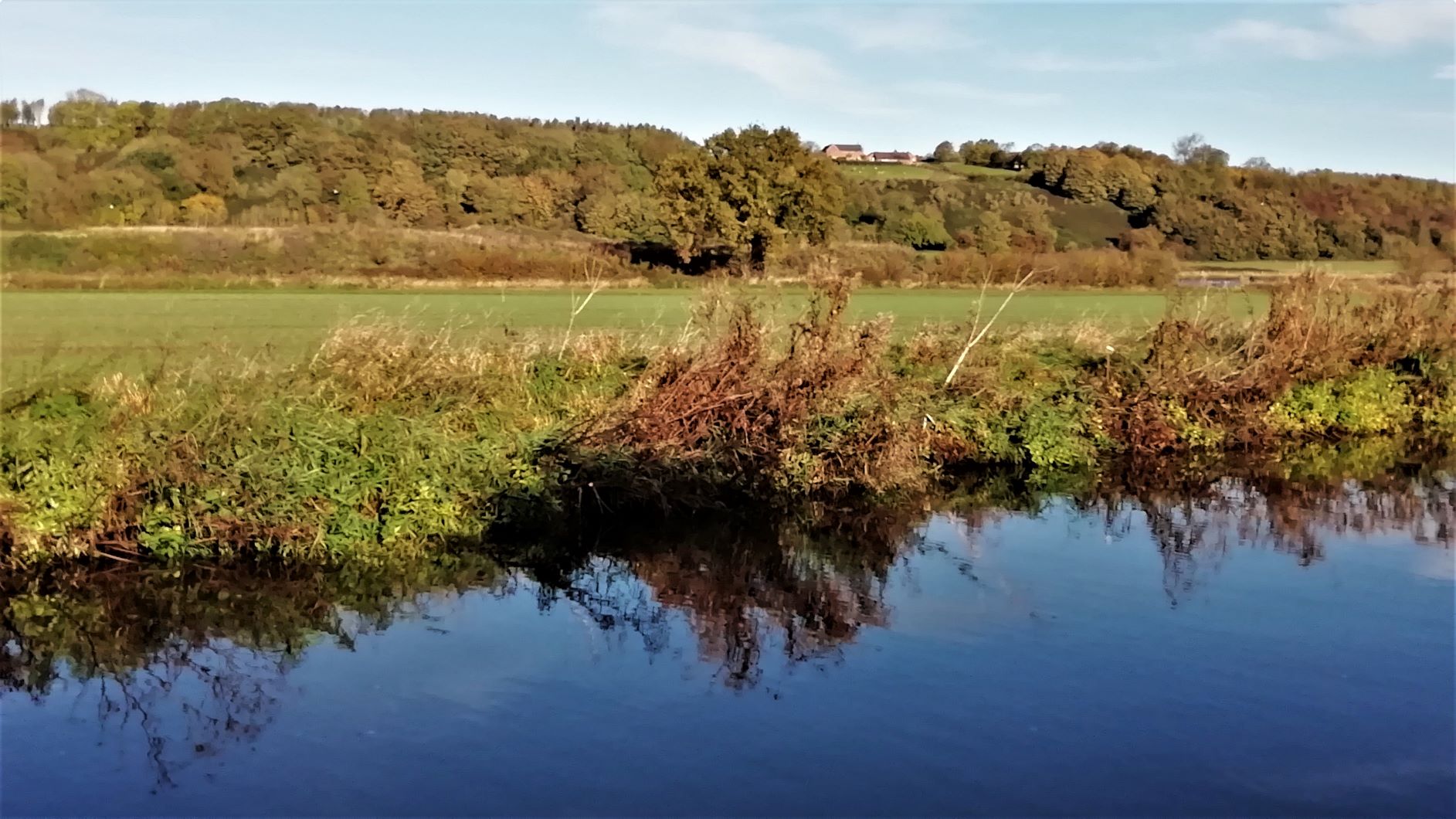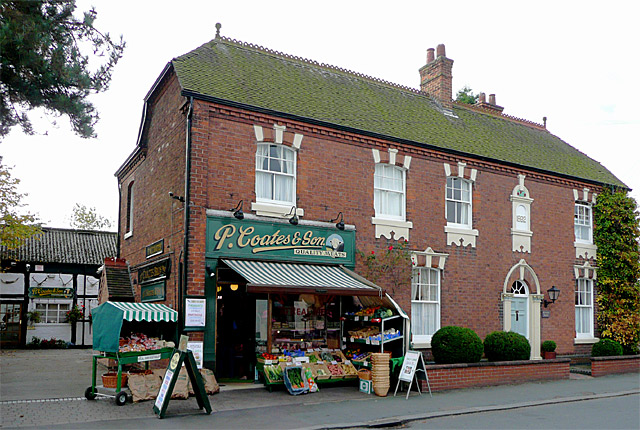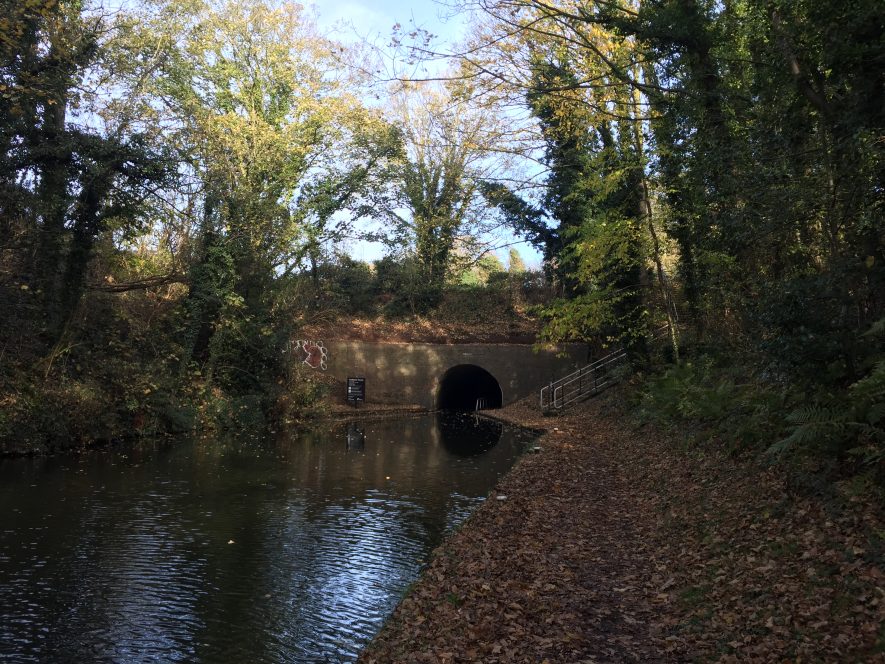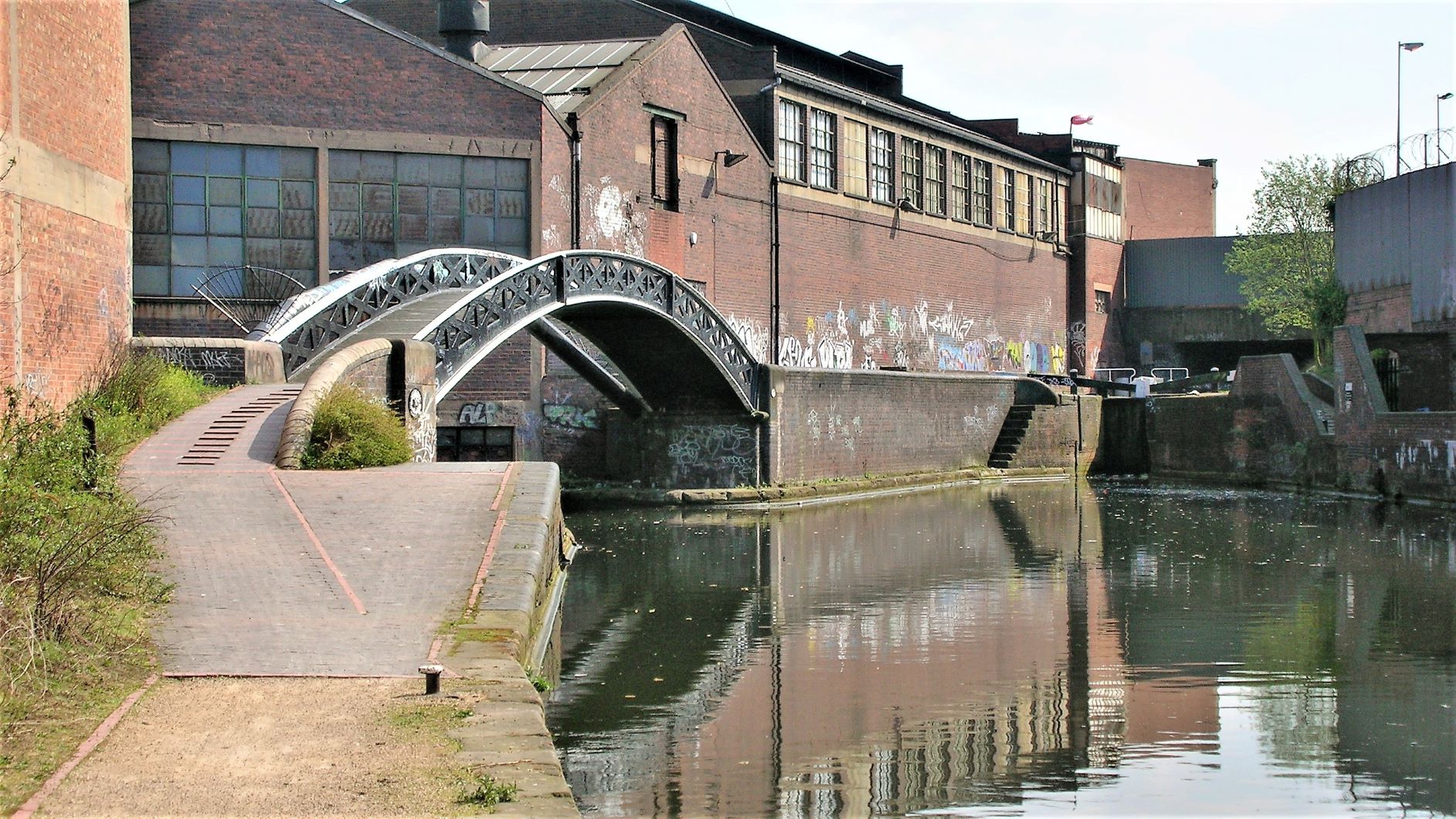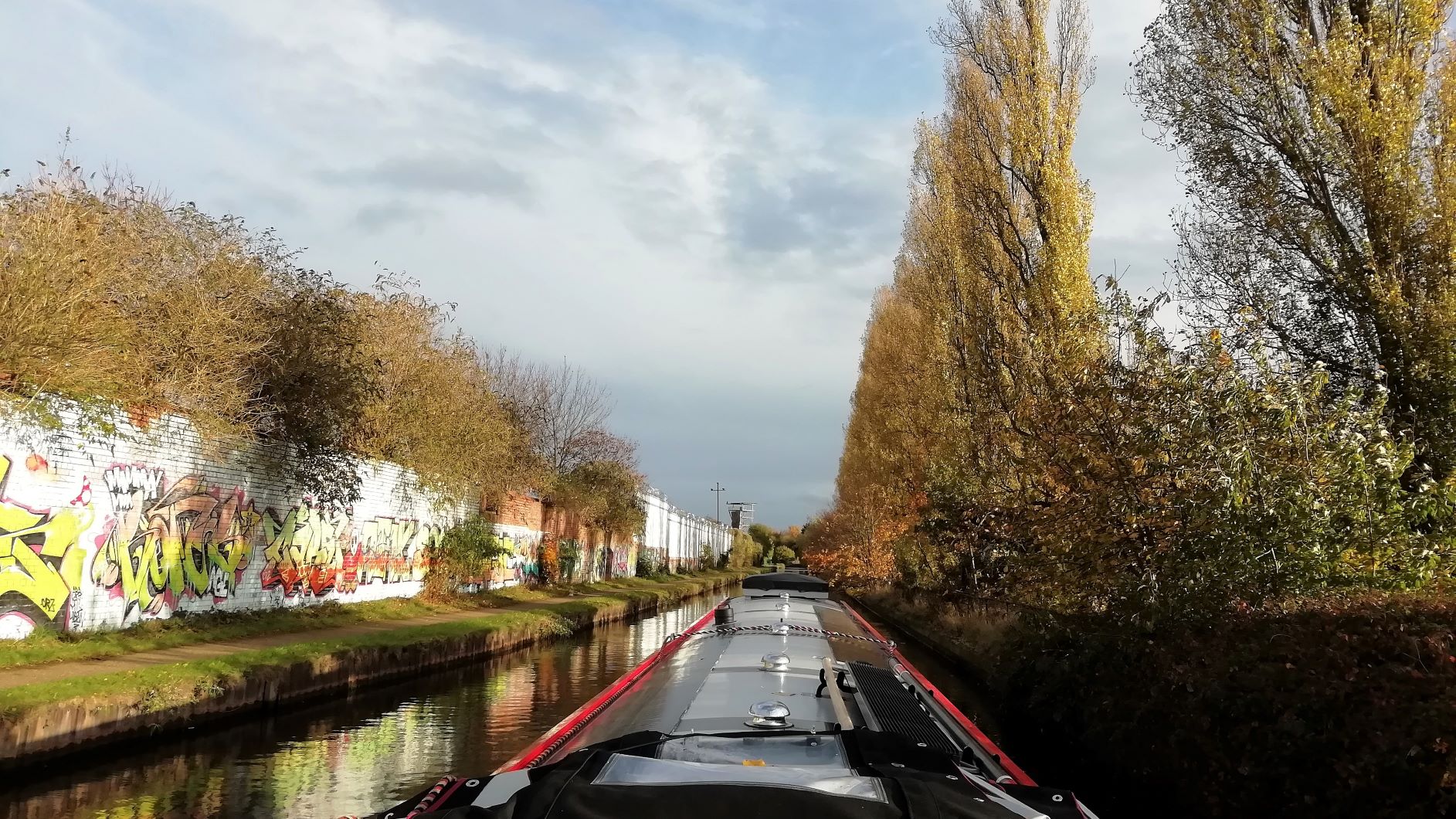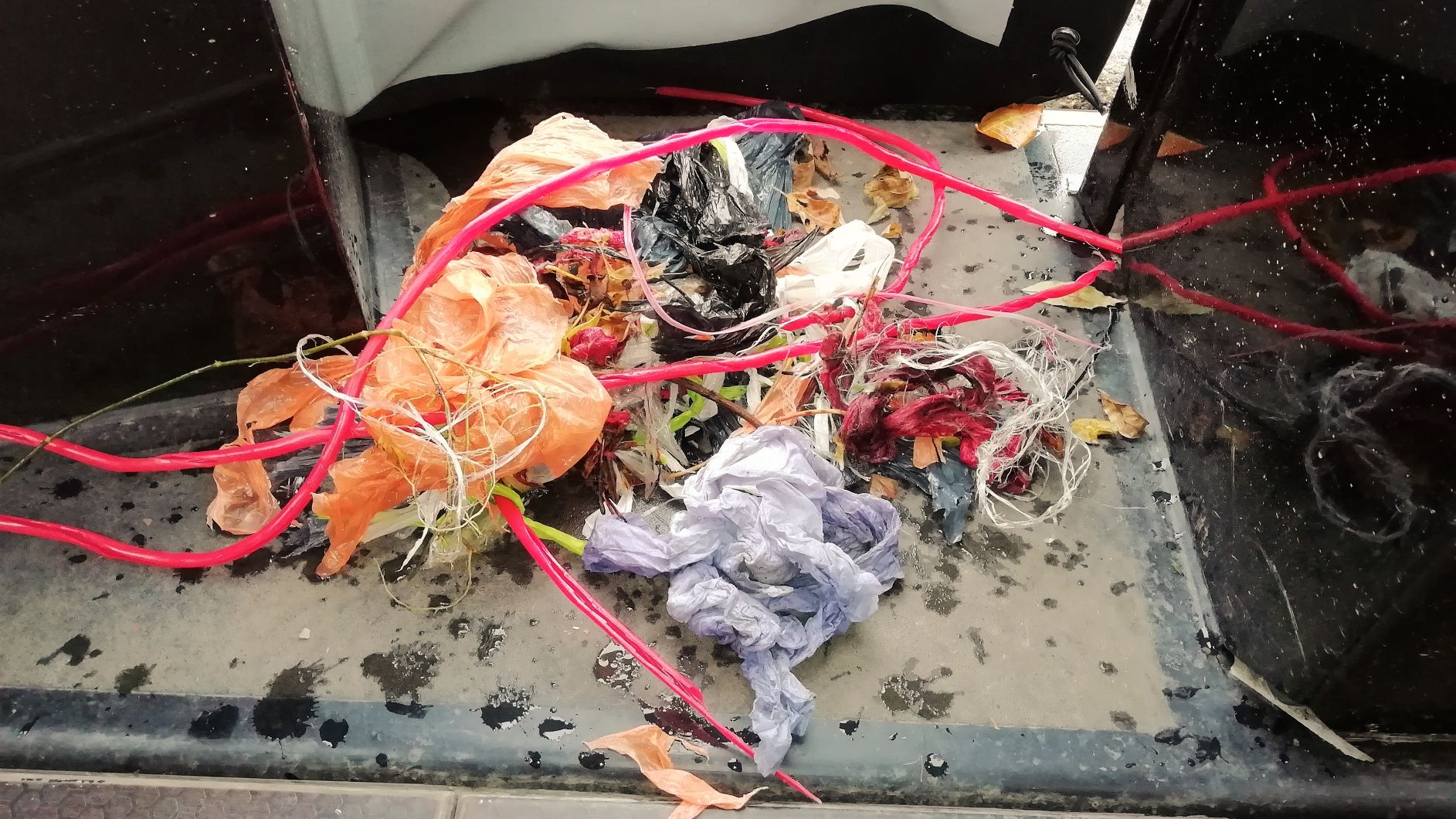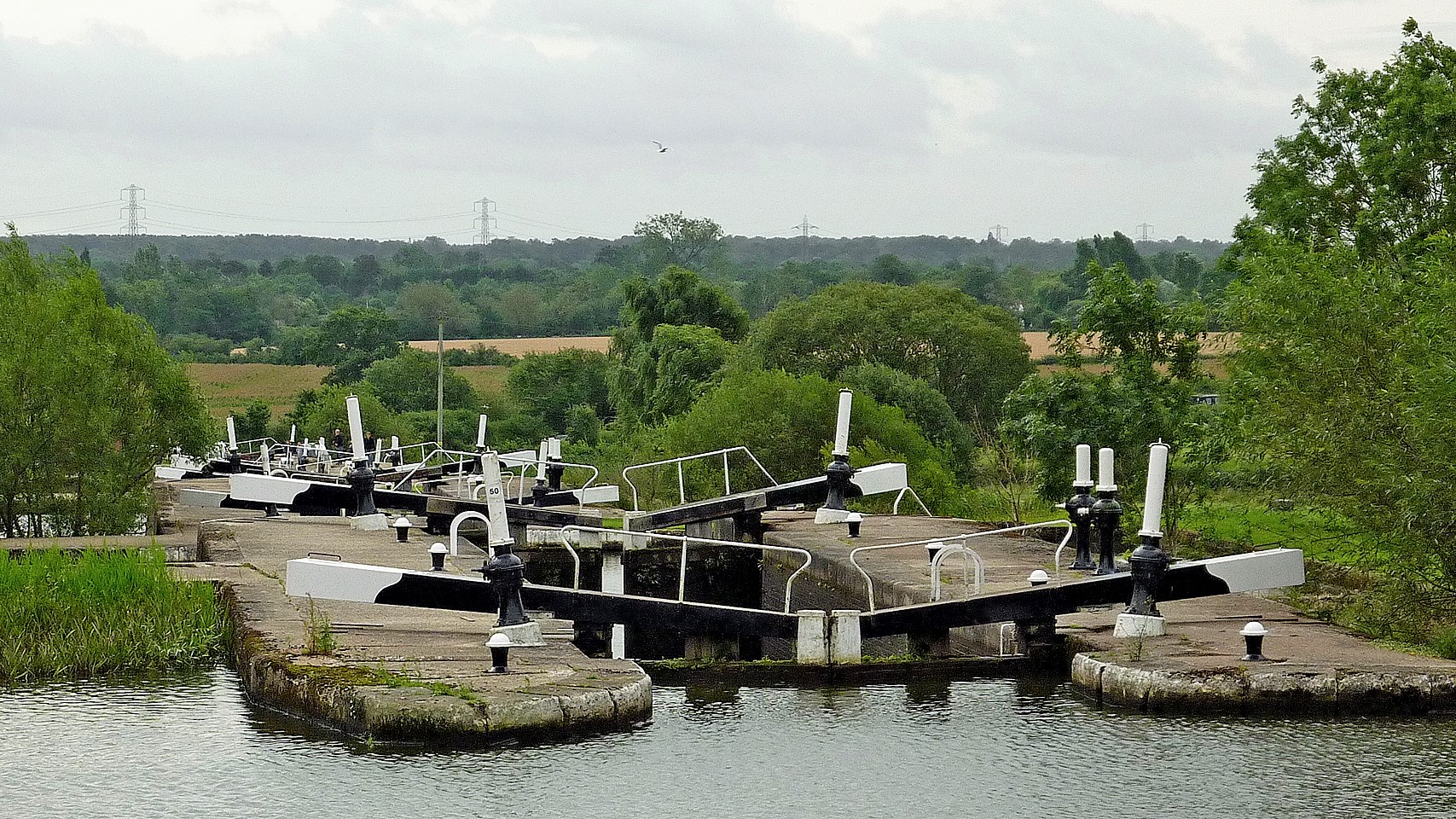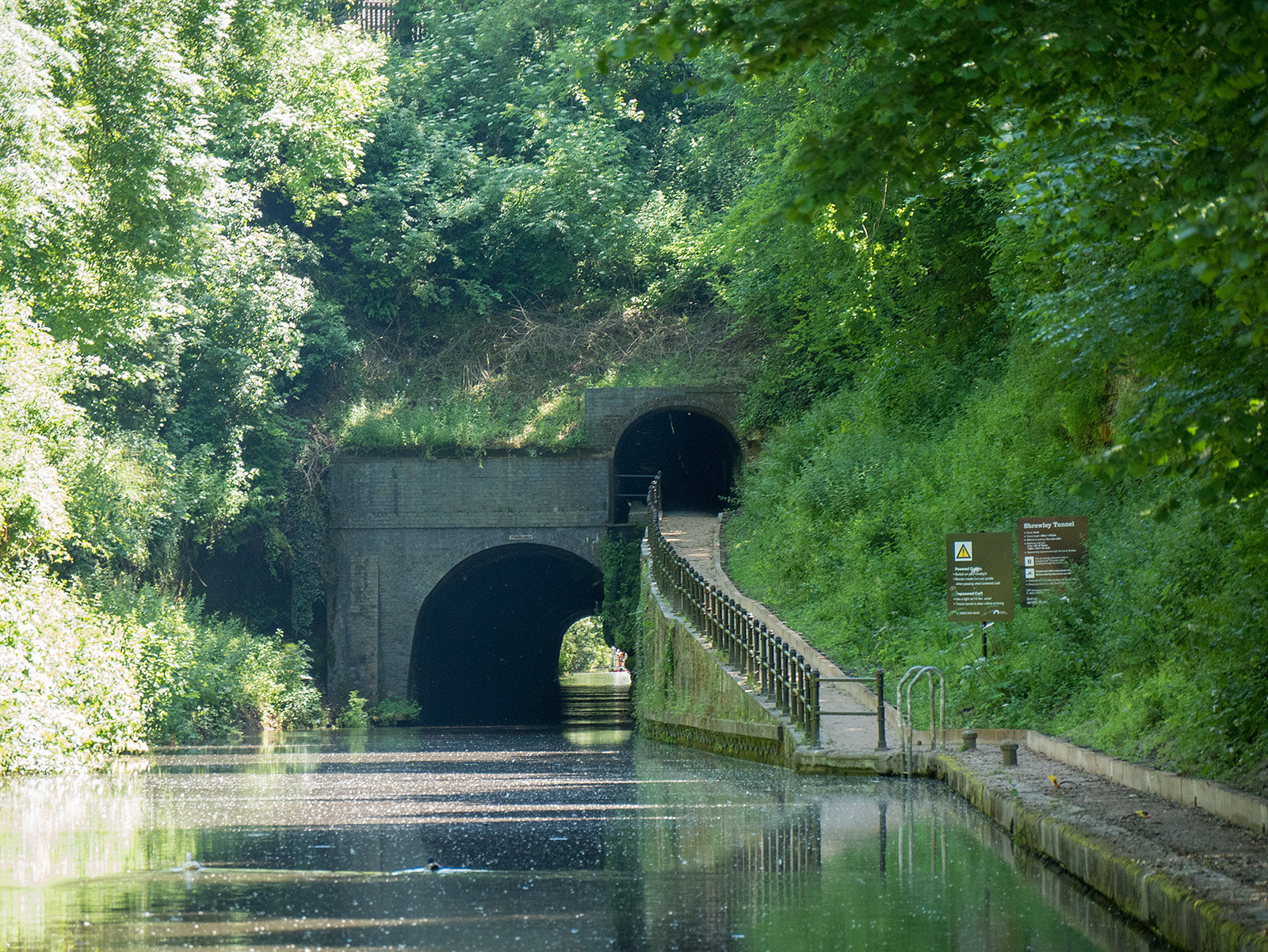On To The Coventry
Over the weekend we received plenty of feedback about transit through Birmingham. Stopping off overnight anywhere between Curdworth, a couple of miles before Birmingham and Catherine De Barnes, a mile or so beyond it, was generally deemed to be unwise. However, the trip between these points could be done in one day, although it would clearly be a long one. We also allowed ourselves to be influenced by Sunday evening's Countryfile weather forecast. This was adamant that Thursday would be a complete washout, so a bad day to attempt this Birmingham stretch, while Wednesday would be an ideal day for it. On our current plan, of course, Thursday would be exactly when we would be there, so we would have to pick up the pace if we wanted to be there a day earlier.
Originally we had thought we would end Monday near the Lichfield Canal, which is now disused except for a short arm held as private mooring by the Lichfield Cruising Club. Instead, we now planned to get as close as we could to Fazeley Junction, five miles further on, ready to turn South West for Birmingham the next morning. That gave us eleven and a half miles, five locks, one junction and one swing bridge to get through as well as a planned stop to take on diesel. We were on the move for six hours and mooring up it was almost dark. On reflection, we should probably have set out before half past ten.
However, we had a reasonable day for weather. We did have two or three short showers but they were light and lasted less than five minutes at a time. Otherwise it was fairly sunny although with quite a brisk, cool breeze. Setting out from Alrewas all the locks for the day were in the first mile and a half, which also happened to be the first hour and a half. There is a service point just before the fifth lock with a café beside it and that was absolutely teeming with people enjoying the autumn sun, even though it was a week day. Perhaps they were all working from home?
The final lock was being operated by CRT Volunteer Lock Keepers, which obviously helped. Fradley Junction, where the Coventry Canal joins from the left, is immediately beyond this lock and we would need to turn into it. I was rather pre-occupied by the enormous seventy foot work boat that arrived from the Coventry while we were ascending the lock. It seemed to me that the space he had occupied to wait for the lock to open, just beyond the top gate, was exactly the space I would need to put our stern in if we were going to make the turn. In fact, we got round okay but in thinking about that I had completely overlooked the fact that at the mouth of the Coventry Canal there is a swing bridge which was currently closed against us. Not having anticipated this we were in quite the wrong position to get off and open it. Luckily, before I started to get involved in any complicated manoeuvring to get over to the side and let Sue off, two ladies out for a ramble saw us coming and sprang into action to open the bridge. They even offered to close it again after us so we just sailed through with a regal wave and continued on our way.
Just past Fradley South, having appeared to have deserted us for good back at Alrewas, the A38 crept up to join us once again and was running alongside a hundred yards away when we stopped at Streethay Wharf for fuel. Here there was a bit of a delay. No-one came out to the landing stage and when I went up to the office and rang the service bell nothing happened either. It was about ten minutes before someone finally emerged, apologising for keeping us waiting. It seems one of the ladies who moor there had just fallen into the canal and they had been busy trying to pull her out and get her dried off. It hasn't been a bad Autumn but it must have been cold in there.
We were done with locks for the day at Fradley so it was a straight cruise from there for about two and a half hours, mostly quite a pleasant run in some weak sunshine but as the light started to go we were pleased to moor up, even though it was beside a Trading estate just by the main A5 crossing.
Winding Back The Clock
In order to be home in time for 3rd November we shouldn't need to go too far each day. As long as we kept on moving we should still have a day or so in hand for the unforeseen. Over the next week, however, we would be forced to go through some part of the Birmingham conurbation so we put out some feelers regarding suitable places to moor overnight on the way through.
In the small hours of Sunday morning the clocks had gone back. This is one of my favourite days of the year. It makes little practical difference, other than to reinforce the fact that nightfall is now in the afternoon, but I do like the feeling of waking up at what appears to be the normal time and suddenly discovering, later in the morning, that you are an hour ahead of the game. Sadly, this is another thing that the unrelenting digitisation of life is beginning to spoil. Most of the clocks adjust themselves automatically overnight so the time you see when you wake up really is the time.
Bracken and I set off on foot on Sunday morning after a run in the park at Shobnall Fields and headed over the bridge to pick up the towpath. It was fine and sunny, if a bit sharp in the wind, with lots of people out and about in the sunshine. We had a fairly easy day ahead with just five locks over seven and a half miles. We started out in the middle of Burton On Trent and soon passed the big brewery but after that, almost immediately, the landscape started to open up and we had some lovely views across the fields, even before we had reached the first lock.
Awl-ree-what?!?
We were heading for the village of Alrewas, supposedly pronounced "Awl-ree-wuss" but no doubt many other versions will be advanced as the authorised version. We knew it was a popular spot for mooring and very busy in the summer but hopefully it would be quieter in October.
The extra hour meant that we were under way unusually early for us and we had a pleasant, straightforward cruise up to Wychnor Lock where the canal rises to take advantage of the River Trent for about a mile before lifting you off it again at Alrewas Lock just before the village. Here, again, there are indicator boards to warn you when the water is too high and you should not proceed but today they were well within the safe markers. It took four hours altogether but we were there in time for lunch. We found there were lots of spaces where we could moor as we passed through the village. However, we carried on almost to the far end to find a spot right opposite the empty playing fields, with plenty of sun for the solar panels and a strong internet signal.
Somewhere back near Willington the dual carriageway of the A38 had crept up behind us and fallen into step, like an unwelcome stranger on the road, with no sense of social distancing. It had followed us ever since, just across the towpath or beyond a hedge, on one side of the canal or the other, sometimes moving away to a slightly less intimidating distance but always returning just when you felt you might have shaken it off. The main village of Alrewas sits on the offside of the canal and is otherwise bounded by this importunate Trunk Road to the East, the flood-prone wetlands below Alrewas Lock to the North and the less aggressive A513, just past Bagnall Lock, to the South. All Saints Church, however, is sited across the water on the towpath side and a few small streets have grown up beside it, including quite an upmarket Indian Restaurant.
Alrewas Parish Council claim that the village is one of the oldest recorded communities in the Midlands and speculate that it may have grown up around an Iron-age farm to service the salt trade from the North West to East Anglia and London, especially when the traders were delayed at the two fords because of flooding. None of this seems very certain and even they don't seem to be able to find any significant claim to fame. We had a walk around the village, its three busy pubs and the upmarket butcher's in the afternoon. It is an attractive place, nicely laid out. It has a lot of well preserved listed buildings and there seems to be quite a strong community spirit.
The lure of an Indian Takeaway proved irresistible, even on a Sunday evening. Between lockdowns pubs were allowed to serve alcohol without the accompaniment of a substantial scotch egg so, having placed our order, we spent a pleasant hour in the very welcoming George & Dragon in the High Street before picking up the food on the way back.
Coventry Interruptus
 About five miles along the Coventry Canal from Fradley Junction, just past where we had originally planned to stop for the night, you suddenly find that the bridges stop having numbers and are identified only by the names, which tend to be long, complicated and difficult to remember in an emergency. On closer examination, although Coventry is still thirty two miles further on, you find that, without warning or any visible distinction, you have transitioned seamlessly onto the Birmingham & Fazeley Canal. Bridge 78 on the Coventry Canal lies behind you but when you check on the map it shows that Bridge 77 is just beyond Fazeley Junction, which is at least five miles ahead.
About five miles along the Coventry Canal from Fradley Junction, just past where we had originally planned to stop for the night, you suddenly find that the bridges stop having numbers and are identified only by the names, which tend to be long, complicated and difficult to remember in an emergency. On closer examination, although Coventry is still thirty two miles further on, you find that, without warning or any visible distinction, you have transitioned seamlessly onto the Birmingham & Fazeley Canal. Bridge 78 on the Coventry Canal lies behind you but when you check on the map it shows that Bridge 77 is just beyond Fazeley Junction, which is at least five miles ahead.
 This is the result of a rather confused picture in canal history. As well as a route from the city, the Coventry Canal was intended to complete the link from the Thames, via the Oxford Canal, with the Trent & Mersey Canal. It was approved by Parliament in 1768. By 1771 it had reached Atherstone, at which point the money ran out and work stopped. In the meantime, the Birmingham & Fazeley Canal was conceived to link the completed Birmingham Canal with the Trent & Mersey via a junction with the Coventry Canal at Fazeley, ten miles beyond Atherstone. Eventually, in 1782, frustrated by the lack of progress of the Coventry, on which their plans depended, the Trent & Mersey and the Birmingham & Fazeley companies took the initiative and proposed that they each build half of the missing link from Fazeley to Fradley Junction, conditional on the Coventry company completing the section as far as Fazeley Junction. The Coventry Canal was completed up to Fazeley and the two parts built by the other companies met at Whittington Brook just north of Whittington Bridge. Presumably the successful completion of this through route meant the Coventry Canal was earning more money because they then found sufficient funds to buy the northern section from the Trent & Mersey Canal Company. This left the section in the middle legally owned and part of the Birmingham and Fazeley Canal. It also presented those subsequently mapping the canals with the conundrum of whether to call that section the Coventry Canal or the Birmingham & Fazeley. Looking at the various maps available, the die seems to have fallen roughly fifty-fifty.
This is the result of a rather confused picture in canal history. As well as a route from the city, the Coventry Canal was intended to complete the link from the Thames, via the Oxford Canal, with the Trent & Mersey Canal. It was approved by Parliament in 1768. By 1771 it had reached Atherstone, at which point the money ran out and work stopped. In the meantime, the Birmingham & Fazeley Canal was conceived to link the completed Birmingham Canal with the Trent & Mersey via a junction with the Coventry Canal at Fazeley, ten miles beyond Atherstone. Eventually, in 1782, frustrated by the lack of progress of the Coventry, on which their plans depended, the Trent & Mersey and the Birmingham & Fazeley companies took the initiative and proposed that they each build half of the missing link from Fazeley to Fradley Junction, conditional on the Coventry company completing the section as far as Fazeley Junction. The Coventry Canal was completed up to Fazeley and the two parts built by the other companies met at Whittington Brook just north of Whittington Bridge. Presumably the successful completion of this through route meant the Coventry Canal was earning more money because they then found sufficient funds to buy the northern section from the Trent & Mersey Canal Company. This left the section in the middle legally owned and part of the Birmingham and Fazeley Canal. It also presented those subsequently mapping the canals with the conundrum of whether to call that section the Coventry Canal or the Birmingham & Fazeley. Looking at the various maps available, the die seems to have fallen roughly fifty-fifty.
All Caught Up At Curdworth
Tuesday was going to have to be another long leg with one junction, eleven locks and a tunnel. We started out in a very damp atmosphere which soon turned to occasional drizzle.
We were less than a mile from the junction but wasted our time pulling in to the water point at Peels Wharf, just before that. It seems CRT sold the whole site a couple of years ago and instead put in an arrangement with Fazeley Mills Marina, half a mile round the junction. When we got there it was an awkward little turn to get into the marina and onto the service wharf. Once there, there was no real option when we had finished but to back out of the narrow entrance into the canal again, which was interesting. We got everything we wanted there and they were very friendly but only after we left did we realise that just past the marina entrance there is a water point on the canal side with direct access on foot to the other services from there. Doh!
We were then an hour from Curdworth Bottom Lock The weather was unkind in bringing on some heavier, persistent rain for much of the passage up the eleven lock flight. The locks were a steady chore in the rain until we got near the top when things got a bit more exciting. Entering the last but one, we found the port side gate would not open fully. A fender dropped down as Sue was moving in to the lock, which jammed on the starboard wall. The boat stopped moving forward and it seemed no amount of forward revs would take it past the obstruction but neither would the boat move backwards. With it stuck so fast, there was no way we could afford to let water in to lift the boat, even if we could have shut the gates. Some violent prodding with the boat hook and the barge pole shifted something eventually and we were able to free it up and get the lock closed and filled. Sure enough, the top lock seemed about to present the same problem but this time we managed to clear some debris from behind the gate and get it fully open before bringing the boat in. Ironically, the blockage seemed to be all down to cuttings from work being done by CRT to clear foliage from the offside of the canal.
Just as we cleared the top lock rain gave way to some weak sunshine, so we had a chance to dry out as we tried to find a suitable mooring with some kind of internet signal. In the end we had to go another half mile, through Curdworth Tunnel and beyond Curdworth Church Bridge, to find somewhere suitable. It had taken six and a half hours to cover just over eight and a half miles but as we had left a bit earlier that morning, we still managed to moor up in broad daylight.
There isn't much to say about Curdworth. The canal is in a fairly steep cutting, the towpath was deep, slick and slippery mud and most of the bank is made up of reeds, interspersed with occasional fishing platforms that offer little scope for mooring. Where we ended up you could tell a road was running just beyond the embankment above us but there was no way to reach it. Walking back to Curdworth Bridge there was a route up to a road which then ran for a couple of hundred yards to junction with the busy A4097. As far as I could tell, in the dark, damp, evening rush hour, it was just a dormitory settlement with little to recommend it except The White Horse, a large inn set back from the crossroads. It was a Vintage Inn and a bit up itself but the bar was warm and cosy enough and they were allowed to serve beer without a substantial meal. Looking back, following the first lock down, these were the days of wine and roses and, indeed, they were not long!
Barging Through Birmingham
The efforts of the last few days had all been aimed at getting to Curdworth, according to some the last safe overnight refuge, and take advantage of the fine weather on Wednesday to get through the worst of Birmingham and out the other side to the next safe haven, at Catherine De Barnes, in a single day. We expected it to be quite a long, hard run so we were up with the lark (one of the older, wearier larks) and set off about eight twenty.
It was half an hour to the Minworth Locks, a group of three with a water point at the top. We were able to take advantage of a hire boat called "Victoria" and her large crew, coming up behind us for the first couple but after that we were on our own for the rest of the day with no-one else moving in either direction. It started raining about nine o'clock and we had to wonder whether we had gone to all this trouble only for the forecast to prove to have been completely wrong. It stopped again soon after, however, to give way to some pale sunshine and eventually quite a fine, dry day.
After the Minworth Locks it was another hour and a half of straight cruising to reach the slightly confusing Salford Junction by Star City. A canal continues straight on but that turns out to be the BCN Tame Valley Canal. The Birmingham & Fazeley turns left here and climbs up into the gentrified centre of Birmingham. An even sharper left turn a few yards before that took us onto the Grand Union Canal, which goes up through the grubby, post-industrial outskirts to Bordesley Junction, via the five locks shown on the maps as either Saltley Locks or Garrison Locks, or sometimes both. We managed to get through these without incident. A little way before the junction we found some mooring rings and as it was one o'clock by now, we stopped for lunch for half an hour.
At the junction the Grand Union turns sharp left and a few yards beyond were the final six locks of the day, Camp Hill Locks. On paper it looked simple enough. Move up to the junction, turn left, pull over to get one of us off to go and open the bottom lock and drive in. We were completely unprepared for the fact that, coming from this direction, there is no lock landing. As we came out from under the iron bridge and around the turn I was standing ready with Bracken to jump off and pull the boat in but suddenly we could see there was no proper landing to jump off to. There was a narrow ledge along the port side and some steps up to the lock. We had been enjoying a cool brisk wind all day but just here it was blowing a gale straight across the canal into the port side of the boat and pushing it hard over to the high brick bank on the far side.
I managed to get onto the ledge but there was no way I could hold the boat against the wind and nowhere to tie it up to if I did. I got the lock open ready for Sue to bring the boat in but it was pinned against the wall. In the end, Sue managed to get it away from the wall and reverse up to try and steer it in but she only made it by piling on the revs and not worrying too much about banging the entrance on the way in.
Looking back from the top of the lock you can see the lock landing back beyond the junction down the Digbeth Branch. Coming up from that direction you can pull in, step off and tie up the boat, cross the Grand Union over the bridge across the entrance and set the lock. Then the boat can push off and have a straight drive through into the chamber. Knowing that now, it is obvious that we should have gone up and set the lock before coming through the junction, so we will know better next time. Unless, of course, we forget.
Half way up the flight the canal passes under the A4540 dual carriageway and takes a long right hand dogleg towards Lock 3. As you come round this long bend there must have been a magnificent view of Holy Trinity Church, Bordesley on the hill straight ahead. These days the view is rather spoiled by the main road and the bridges supporting several railway lines.
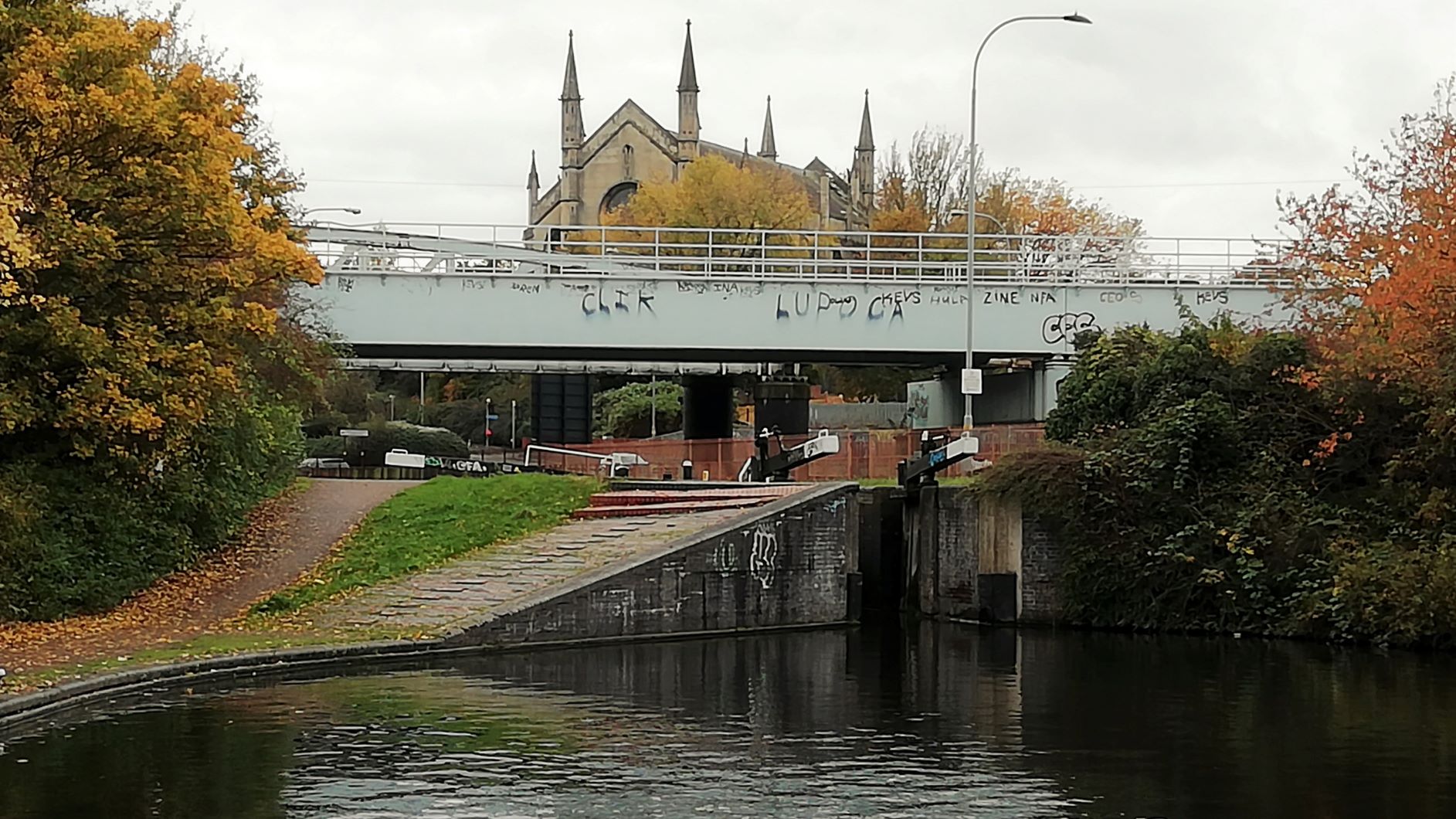 Having got into the bottom lock the passage up the rest of the Camp Hill flight was simple enough and we were pulling in at the service point beyond the top lock to dump our rubbish in an hour and a quarter. There is a fairly secure mooring here and some people had suggested it as an overnight stop, although others had advised against it. It was still very much in the city, though. We had planned to carry on to the next visitor moorings at Catherine De Barnes and at this stage, with no more locks in between and a fine, sunny afternoon, there was no reason to stop short.
Having got into the bottom lock the passage up the rest of the Camp Hill flight was simple enough and we were pulling in at the service point beyond the top lock to dump our rubbish in an hour and a quarter. There is a fairly secure mooring here and some people had suggested it as an overnight stop, although others had advised against it. It was still very much in the city, though. We had planned to carry on to the next visitor moorings at Catherine De Barnes and at this stage, with no more locks in between and a fine, sunny afternoon, there was no reason to stop short.
We had about seven and a half miles to go and had now climbed up from Bordesley onto Birmingham Small Heath, most recently made famous as a central location for the action in 'Peaky Blinders'. Having been developed in the Victorian era Bordesley and Small Heath were then among the worst of Birmingham's slums and subject to slum clearance in the early 1960's. The graffiti and industrial decay might suggest we have come full circle but high walls on one side and open green spaces on the other seemed to be keeping the city away from us and it was very pleasant and relaxing to start with.
We did seem to be moving quite slowly, however. The steering of the boat seemed fine and there was nothing to suggest there was anything significant wrapped around the propeller. At this time of year the leaves are falling into the canal. When there are enough of them they do start to fold themselves around the propeller, gathering more and more thickly and interfering with the propulsion. A quick blast in reverse will unwind them and cast them off and you can carry on until it happens again. We were doing this quite frequently on this stretch and still seemed to be crawling along, These things are subjective, however, there is no speedometer on a narrowboat. They do move slowly and we were keen to get the day over, so it was natural to feel that time was dragging. The light faded and darkness fell. We passed under the last bridge but one to enter a long cutting and we had to put on the tunnel light and try to steer by that. That last mile seemed to take forever and as we went under the last bridge, just before the moorings, we began to wonder if there would be room for us. The idea of having to continue in the dark to try and find another mooring was too awful to contemplate.
There was one space. As far as we could tell in the darkness it didn't look quite long enough for us but we decided it would have to be made to fit, we simply weren't going any further. In the event, when we pulled her in, we had about six inches to spare at either end. Nine and a half hours, fourteen locks and sixteen miles was rather more than we had signed up for so it was a huge relief to be able to settle down for the evening and warm ourselves up again.
A New Home In Hatton
The point of putting in extra miles in the last few days was to ensure we wouldn't be doing the very long stretch to Catherine De Barnes on Thursday, which was going to see a deluge of rain and strong winds. Now we were there, we could set up the pram hood, stay put in the dry and get some domestic chores done while it blew over. It was a bit disappointing, then, to find that throughout the whole day, despite a certain amount of light spitting, there was virtually no rain and nothing exceptional in the way of wind. Nevertheless, we got to relax and get over the efforts of the last few days. Even though I hadn't really felt any problems on the previous afternoon and had thought it was just autumn leaves slowing us down, I went down the weed hatch to see if there was anything there. We came up with quite a haul of Sainsbury's carrier bags, rope, complete bin bags and several yards of electrical cable insulation, thankfully without the inner copper wires. It was clear that the prop won't have been spinning at its best and clearly I am going to have to check more often, whether it feels odd or not.
The name Catherine De Barnes, according to Wikipedia, originates from Ketelberne, the man who owned it after the Norman Conquest in 1066, which you can sort of see. It is known locally as Catney. Why, I couldn't discover. It isn't really an obvious corruption, although it is a lot shorter to say and write. Just across the bridge by the mooring there is a pretty well stocked Nisa Local, which seems to have a deal with Co-op to supply their food products. This is next door to quite a fancy restaurant and opposite The Boat pub, which we had planned to visit. Sadly, the pub was completely closed for renovation, a bitter blow on Wednesday night when we could really have done with a drink! I took Bracken out for a walk around some of the local lanes and footpaths and that really seemed to be about it, despite being so close to Solihull.
Another reason to be getting back to Hatton this weekend was the closure of Knowle locks for winter maintenance work from Monday the 2nd November. Given the number of canals around Birmingham, if we had wanted to stay out much longer, we could have worked our way around it but we already needed to get back.
Friday was again supposed pretty wet so we got going fairly early, for us, to get as much done before it started. Once again, the rain never came. After half an hour we stopped at Copt Hill Wharf to top up the diesel tank and another half hour from there saw us emerging from a nicely protected cutting at the approach to the locks.
The Knowle flight were the last five locks between us and our winter mooring. We had started to receive dire warnings about them from Mike Fielding and Neil Payne. The locks are fairly close together and drop you over twelve and a half metres in about a mile. The land around them is wide open so they are notorious for a permanent, strong wind blowing straight across them, to frustrate the efforts of the most skilful navigator attempting to make a contact-free passage. When we arrived, we could feel the effects of the wind at once. We were going to stop at the water point just before the locks and found that it really was just beside the top lock. Convenient in a way, it made for an awkward sidestep across and against the wind to get into the lock once we had finished there. It is always easier to get through these flights when there are more people and when there are two boats in the lock to damp down the range of movement as the water rushes out. Here we found we not only had the assistance of some CRT Volunteer Lockkeepers, "Peggy", with a crew of willing helpers on board, arrived to go down just as we were ready to set off. With no issues or incidents on the way and all this assistance we were through all five locks in just about forty minutes.
With no more locks and some quite nice sunshine it was easy cruising from here. There are several pubs along this stretch, many of which we have never tried but we had decided that we would spend the night at the visitor moorings by an old favourite, Tom O' The Wood near Rowington. We were moored up there by lunchtime and as the rumoured rain showed no sign of arriving we had time for a walk in the afternoon. This spot is not far past Kingswood Junction so we were able to walk across to the Stratford upon Avon Canal and follow the towpath north to the Lapworth Link round the link to the junction and back down the Grand Union to the boat. We had booked a table for dinner, as it was our last night before going onto our winter mooring on Saturday and returning home on Sunday. Despite the great unpleasantness and the increasing likelihood of being returned to national confinement, it was much as we remembered and the staff had even decked the pub out for Halloween. We had a very nice meal there, particularly enjoyable as we had a feeling it might be our last!
We were only an hour or so from our final destination and we chose not to rush but to wait until the promised rain had cleared in the morning. This time it certainly did come down in buckets, so this turned out to be a good choice. The rain did stop by about 12:30 and we set off after lunch in fine, sunny weather although quite windy and cooler with it. The only feature on our route, Shrewley Tunnel, was less than four hundred metres long and offered no real challenge, although it does have one unusual feature. Like a lot of tunnels it has no towpath running through it. The horses would have been unhitched and sent over the top to meet the boats at the far end. Here at Shrewley however, they start that journey by going through a second tunnel of their own, although only for forty metres or so.
We were moored up in good time to settle down and watch England beat Italy 34-5 in Rome, which was nice, although, despite the score line, "fumbled to a win" would be a more accurate description than "stormed to victory". We also got the less welcome but rather expected announcement that from Thursday we were all invited to stay at home, once again, at least until December.
Arriving at the mooring site we had known where we would be in the pecking order. It is an online mooring, basically a section of the offside bank of the canal. There are facilities and a nice clubhouse at the Hatton Station end, by the gate, however it is a strict rule that the newest members start furthest back and work their way up the line, over time, stepping into dead men's shoes. As winter-only moorers we are also second class citizens, with no voting rights, in a group of new winter arrivals who all had instructions to take the first available space at the farther end as each boat arrived. Clearly we were the last ones out on the cut, as the first available space was also the only available space and was as far from anything as it was possible to be.
It was certainly a long walk with the wheelbarrow the next morning, about a quarter of a mile each way, to go back and forth preparing the boat to be left unattended and clearing our luggage up to where we could meet the taxi. That was expected anyway and looking around it had its advantages. The phone and internet signal at that end was far better than down by the clubhouse, where it was virtually non-existent. We had a water point close by the boat and access to an electricity supply, although only at 3 amps. No-one had any reason to go up and down past our boat and the outlook where we were was on open fields rather than the houses and gardens backing onto the berths nearer the gate. We were even a fair way further from the railway line, which starts off right next to the canal by the station but has veered off to avoid Shrewley by the time it is opposite our mooring. All in all we could do far worse.
We had booked our local taxi driver earlier in the week and he was waiting for us, prompt as ever, on Sunday morning. We still had until Thursday to get a drink or eat out if we wanted to before the pubs were closed again. As it happened Sunday night was the most a convenient time to meet up so we celebrated our homecoming with Mike and Lesley Fielding at The Wharf Inn by the canal in Fenny Compton. Who knows when we will next enjoy such privileges?

